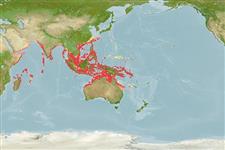Common names from other countries
>
Eupercaria/misc (Various families in series Eupercaria) >
Caesionidae (Fusiliers) > Gymnocaesioninae
Etymology: Dipterygonotus: Greek, di = two + Greek, pteryx = fin + Greek, gono, gone = birth + Greek, noton = back (Ref. 45335).
More on author: Valenciennes.
Environment: milieu / climate zone / depth range / distribution range
Sinh thái học
Biển Cùng sống ở rạn san hô; Mức độ sâu 37 - 91 m (Ref. 26165). Tropical; 28°N - 24°S, 43°E - 163°E (Ref. 402)
Indo-Pacific: East Africa, not including the Red Sea or Arabian (Persian) Gulf, to the Solomon Islands.
Bộ gần gũi / Khối lượng (Trọng lượng) / Age
Maturity: Lm ? range ? - ? cm
Max length : 14.0 cm TL con đực/không giới tính; (Ref. 402)
Các tia vây lưng cứng (tổng cộng) : 12 - 15; Các vây lưng mềm (tổng cộng) : 8 - 11; Tia cứng vây hậu môn: 3; Tia mềm vây hậu môn: 9 - 11.
Primarily a near-shore pelagic species (Ref. 30573), but swims mainly in open water away from reefs (Ref. 48636). Forms dense aggregations (Ref. 90102). Mixed with other planktivores and is easily overlooked. Feeds on zooplankton (Ref. 30573). Oviparous, with numerous, small pelagic eggs (Ref. 402). Caught at night using lights and dip nets (Ref. 30573). Important tuna bait fish in some countries (Ref. 30573).
Life cycle and mating behavior
Maturities | Sự tái sinh sản | Spawnings | Egg(s) | Fecundities | Ấu trùng
Carpenter, K.E., 1987. Revision of the Indo-Pacific fish family Caesionidae (Lutjanoidea), with descriptions of five new species. Indo-Pac. Fish. (15):56 p. (Ref. 1723)
IUCN Red List Status (Ref. 130435)
CITES (Ref. 128078)
Not Evaluated
Threat to humans
Harmless
Human uses
Các nghề cá: buôn bán nhỏ; mồi: usually
Các công cụ
Special reports
Download XML
Các nguồn internet
Estimates based on models
Preferred temperature (Ref.
115969): 23.8 - 28.4, mean 27.4 (based on 421 cells).
Phylogenetic diversity index (Ref.
82804): PD
50 = 1.0000 [Uniqueness, from 0.5 = low to 2.0 = high].
Bayesian length-weight: a=0.01122 (0.00514 - 0.02450), b=3.04 (2.87 - 3.21), in cm Total Length, based on all LWR estimates for this body shape (Ref.
93245).
Mức dinh dưỡng (Ref.
69278): 3.4 ±0.45 se; based on food items.
Thích nghi nhanh (Ref.
120179): Chiêù cao, thời gian nhân đôi của chủng quần tối thiểu là dưới 15 tháng (Preliminary K or Fecundity.).
Fishing Vulnerability (Ref.
59153): Low vulnerability (10 of 100).
